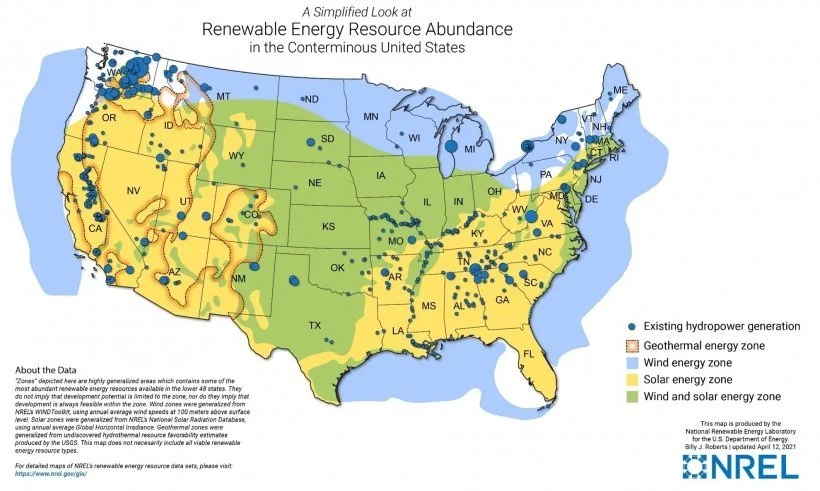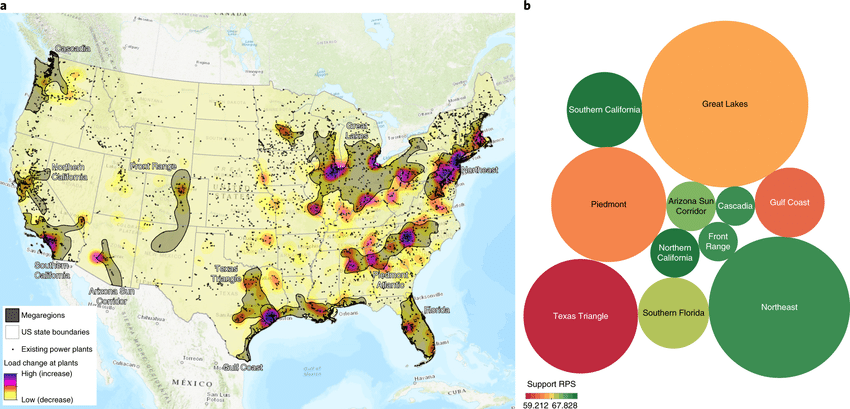by Maeve Hulsman-Wells
The US is overdue for an energy overhaul. Reliance on fossil fuels has damaged the Earth and left animal and plant life vulnerable to extinction. A transition to clean, renewable energy sources like solar and wind would improve the outlook for our planet. But, our grid isn’t prepared for a shift, leading to grid congestion—a billion-dollar problem.
The grid is a web of interconnected transmission and distribution lines that move power from generators, like power plants, to electricity consumers. As the US integrates renewable energy, the amount and the distance power is traveling through the grid is greater than its capacity to handle. Thus, grid congestion occurs when the energy gets stuck, damaging the grid, and causing blackouts.
A simplified power grid. Image: Marshall Brain, Smith College
Congestion is problematic chiefly because electricity is critical to maintaining essential services, including air conditioning, which has become even more important in recent years. Additionally, when the grid is congested, the utilities supplying power must send electricity from more expensive sources, costing consumers an estimated $20.8 billion in 2022 alone and projected to increase through 2023 as electricity demand rises.
The American electricity grid is old, built around fossil fuel resources where transmission lines carry power between a patchwork of power plants that service local consumers. Renewable energy must be generated where the renewable resources are most plentiful—where the wind blows and the sun shines strongest, for example. These locations are often in rural areas far from where electricity demand is highest, meaning it must travel long distances to reach most users. But to meet climate goals, renewables must be dramatically increased. Without improving the grid, congestion will increase and the reliability of renewables will suffer. This point has been taken advantage of politically to deny the necessity of clean energy development. In the end, Americans will suffer from this loss, so solving grid congestion is a priority.
This is a map of the Renewable Energy Potential in the US. Wind energy potential in particular is found in some difficult-to-reach areas. Image: Billy J. Roberts for the National Renewable Energy Laboratory
Ideally, an overtaxed grid is improved by improving interconnection—expanding the number and range of the high-voltage transmission lines that carry energy from its source to its end use. A set of retrofitting collectively called grid-enhancing technologies (GETs) would also help the grid function more reliably. One GET option is reconductoring, where existing transmission lines are restrung with more efficient cables that can deliver more energy.
Many proposed solutions hit political barriers, however. Building high-voltage transmission lines is difficult because of the number of stakeholders involved—private landowners, federal, state, and local regulations, tribal input—and the number of legislative and regulatory hoops developers must jump through. The body of legislation governing interstate construction is large, so attaining permits for these projects can take years. Even GETs are difficult to secure: utilities' business models make the return on investments (ROIs) much higher for larger projects, such as grid expansion, than ROIs for upgrading existing portions of the grid, leaving it financially unattractive to invest in GETs.
Projected grid congestion increases over the next 35 years. The Northeast and the Great Lakes region are projected to experience higher levels of grid congestion under the current grid capacity. Image: DeRolph, Christopher, et al., Nature Sustainability
Public and political support for expanded renewable power generation remains high. So, electricity is likely to be added to the grid, increasing congestion but without improving the grid's capacity. The federal government allocated money from the Inflation Reduction Act to expand the grid, and, more recently, the Federal Energy Regulatory Commission passed a set of reforms to streamline the permitting process necessary for interconnection. These efforts acknowledge the system-wide weaknesses in the grid. With the imminent threat climate change and the related, major weather shifts pose to American households, industry advocates report that more short-term solutions are needed, which are yet unclear.





